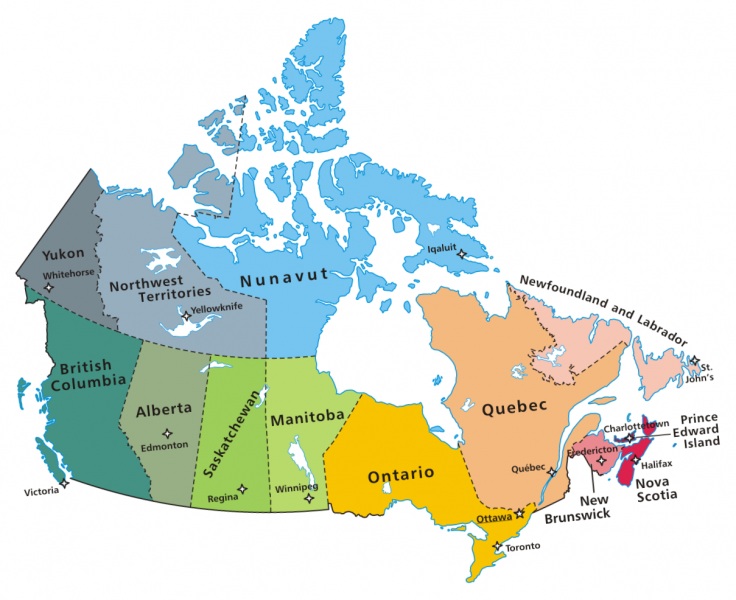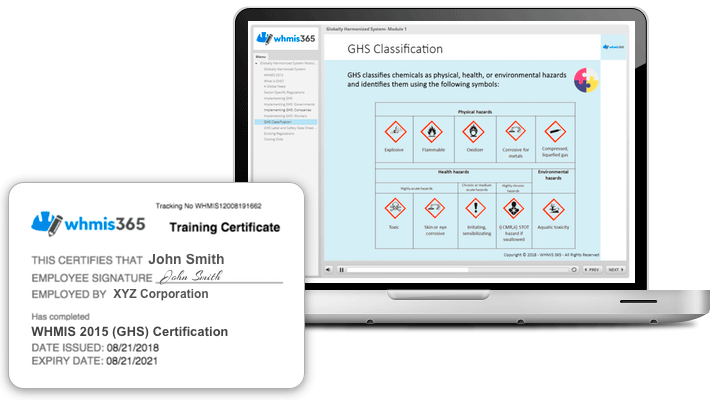WHMIS by Province

WHMIS 2015 is enforced differently in different provinces and territories. Understanding the way WHMIS is legislated, regulated, and enforced in different provinces, territories, and regions is the only way to make sure that you and your employees are legally and physically protected. Read more about WHMIS by province to make sure your workplace is fully compliant with WHMIS 2015.
WHMIS is a federal system that differs in its implementation in each region. The Workplace Hazardous Materials Information System, or WHMIS, has been in place as Canada’s nationwide workplace hazard communication system since 1988. In 2015, Canada adopted GHS into WHMIS, and the new standard is now known as WHMIS 2015. Transitioning to WHMIS 2015 at the federal level took place in three distinct phases. The final deadline for the transition was in December of 2018. Everyone in Canada, from manufacturers and distributers to workers and employees are now expected to be compliant with WHIMIS 2015.
WHMIS by Province and Territory
WHMIS in Canada is implemented through coordinating legislation at the federal, provincial, and territorial levels. The Constitution of Canada stipulates that most labor legislation and regulation falls under the jurisdiction of provinces and territories. Though Canada has adopted WHMIS 2015 on a federal level, each province and territory will establish employer requirements within its own jurisdiction, and each province and territory will differ in its implementation of WHMIS 2015, from employer requirements to the timeline of compliance.
Though some industries operate under federal regulation, and these are subject to federal WHMIS legislation, most of the time WHMIS is enforced by provincial or territorial health and safety government departments or agencies. Keep reading to learn more about WHMIS requirements in your province or territory.
WHMIS 2015 in British Columbia
In British Columbia, the amendment to incorporate GHS took effect in 2015, and employers were given through November 2018 to ensure their companies and employees were GHS compliant and certified. Until November 30th, 2018, employers are allowed to have both WHMIS 1988 and WHMIS 2015 labels in their workplaces, as long as employees are trained and certified in both systems. By December 1st, 2018, all employers and workplaces must be WHMIS 2015 compliant, using only WHMIS 2015 labels and SDSs.
In the jurisdiction of British Columbia, employer requirements are laid out in the Occupational Health and Safety Regulation, Part 5: Chemical Agents and Biological Agents of the Workers Compensation Act, and enforced by the Ministry of Jobs, Tourism and Skills Training.
WHMIS 2015 in Yukon
In Yukon, employer requirements are mandated in the Occupational Health and Safety Regulations, WHMIS Regulations of the Occupational Health and Safety Act, and enforced by the Department of Community Services.
The new WHMIS regulations took effect in Yukon in July 2015, and WHMIS 2015 will be in full effect as of December 1 st , 2018. Employers will have three years after the December deadline to be fully compliant with WHMIS 2015, unless a product with a WHMIS 2015 label is received in a workplace. As soon as such a product is received, employers must immediately comply with worker education and ensure that all workers are fully trained and certified under the new system. Under WHMIS 2015, all SDSs must be offered in either French or English, depending on the needs of the workplace.
WHMIS 2015 in Ontario
Different provinces will vary slightly in their implementation of WHMIS 2015. Safety Data Sheets, or SDSs, are maintained and provided to employees in languages determined by each province. In Ontario, SDSs are required to be provided in English, with any other language options to be determined by the individual workforce.
The original WHMIS 1988 required that all SDSs be updated every 3 years. In keeping with the updated GHS protocol, Ontario will now require that SDSs be accurate at the time of sale. Suppliers and manufacturers in Ontario will be required to update SDSs within 90 days of becoming aware of any significant new data. This includes any information that changes how a hazardous product is classified, stored, or handled, as well as changes in personal protection strategies and necessary protective clothing or gear.
It is the responsibility of suppliers and employers to make sure that their workplaces, SDSs, labels, and employees are all compliant with Ontario’s WHMIS 2015 requirements. Make sure that your employees’ certifications are up to date, and check with your provincial and local jurisdictions for more information about Ontario’s requirements.
WHMIS 2015 in Quebec
The majority of Quebecers (or Québécois) speak French as a first or second language. Because of this, the Charter of the French Language (Charte de la Langue Française) has made French the language of business in Quebec, which means that Safety Data Sheets, or SDSs, must be provided to employees in French as well as English. The SDS may be provided as one bilingual sheet, or as two separate SDSs, one each in English and French.
Under WHMIS 1988, all SDSs needed to be updated every 3 years at minimum. The updated WHMIS 2015 system now requires that the SDSs for a product be accurate at the time of sale. Manufacturers and suppliers will have a 90 day window to update the SDS once they become aware of any significant new data regarding the product in question.
WHMIS 2015 in New Brunswick
The new WHMIS regulations took effect in New Brunswick in April 2016. Suppliers and manufacturers were permitted to comply with either WHMIS 1988 or WHMIS 2015 until June 1 st , 2017. After the June deadline, all manufacturers and importers were required to comply with WHMIS 2015 alone. Employers were given until December 1st, 2018 to comply with the new system. By the December 2018 deadline, all manufacturers, importers, and employers are required to have only WHMIS 2015 compliant labels and SDSs in every workplace.
In New Brunswick, employer requirements are outlined in the Workplace Hazardous Materials Information Regulation, NB 88-221 of the Occupational Health and Safety Act. These requirements are enforced by The Department of Post-Secondary Education, Training and Labour.
WHMIS 2015 in Northwest Territories
All employers, manufacturers, suppliers, and workers in the Northwest Territories will be expected to be fully compliant by December 1st, 2018. Though WHMIS 2015 is a federal law, official language requirements are one of the major differences in the ways that individual provinces and territories, including the Northwest Territories, are adopting the GHS/WHMIS 2015 system. Because indigenous people form a majority of the population of the Northwest Territories, Safety Data Sheets, or SDSs, are required to be provided in English, French, and 11 other official languages upon request.
Throughout the transition period, many workplaces in the Northwest Territories were permitted or required to use both WHMIS 1988 and WHMIS 2015 labeling and SDS practices, as long as each individual product only used one system, rather than a combination of the two. By December 1st, WHMIS 2015 should be the only system used in the Northwest Territories. During the transition, and after the December deadline, everyone – including suppliers, employers, and employees – who works with or near hazardous materials should be fully certified for the WHMIS 2015 system.
WHMIS 2015 in Nunavut
By the December 1st, 2018 deadline, all suppliers, manufacturers, employers, and employees in Nunavut must be fully compliant with WHMIS 2015. Implementation of WHMIS 2015 will vary throughout Canada, as employers fall under the jurisdiction of different provinces and territories. Employers that fall under the jurisdiction of Nunavut may have different responsibilities than employers in other territories or provinces. One such difference will be the language that SDSs are provided in. In Nunavut, which is home to a majority population of indigenous people, documents must be offered in English, French, Inuinnaqtun, and Inuktitut.
In Nunavut, WHMIS GHS employer requirements are outlined in the Work Site Hazardous Materials Information System Regulations of The North-West Territories and Nunavut Safety Act and enforced by the Department of Human Resources. As Nunavut transitions into GHS compliance, suppliers and employers will use WHMIS 1988 or WHMIS 2015, but never a combination of the two for a single product.
WHMIS 2015 in Sasketchewan
Saskatchewan released its final provincial amendments and changes to the new WHMIS 2015 system in August of 2016. This set into motion the formal provincial adoption of the WHMIS 2015 system, which updates the old WHMIS 1988 system by incorporating the Globally Harmonized System, or GHS.
By December 1st, 2018, all Saskatchewan employers must be fully compliant with the new WHMIS requirements. During the transition period, workplaces must be fully compliant with WHMIS 1988 or with WHMIS 2015, but not both. This means that workplaces are free to use and train for WHMIS 1988 until they receive a product with a WHMIS 2015 label and SDS, at which point everyone in the workplace must become certified for WHMIS 2015.
Check with your provincial and local jurisdictions for updates about Saskatchewan’s SDS and labeling requirements. In Saskatchewan, employer requirements are dictated by part XXII of OHSA Regulations and enforced by the Ministry of Labour Relations and Workplace Safety. All employees have the right to be safe in the workplace. This means that employers must make sure their workplaces, labels, and SDSs are GHS compliant, and their employees are WHMIS 2015 certified.
WHMIS 2015 in Manitoba
Manitoba finalized the amendments to the Workplace Safety and Health Regulation on July 31st, 2015. Employers are now mandated to ensure that all hazardous products received in the workplace have the correct label and MSDS/SDS, and that all employees are trained for WHMIS 1988, WHMIS 2015, or both, depending on which is being used in the workplace. Both systems will be concurrently permitted until December 2018, at which point all WHMIS 1988 labels and MSDSs must be completely replaced by WHMIS 2015 compliant labels and SDSs.
In Manitoba, the WHMIS 2015 system will be enforced by the Department of Family Services and Labour. The Workplace Safety and Health Regulation also dictates that Manitoba SDSs be offered in English or French, depending on the workforce, and that SDSs be retained at least 30 years after a product is no longer used in the workplace.
WHMIS Requirements For Everyone
Despite slight differences in implementation across Canada's provinces and territories, the bottom line of WHMIS requirements remains the same across the nation. Everyone has the right to be safe at work. Employers in every region are liable for keeping employees safe, and doing due diligence to make sure workers are WHMIS 2015 compliant according to federal and provincial requirements.

WHMIS 2015 (GHS) Certification
$19.95
Regular Price: $ 29.95We provide both Team or Individual certification training for WHIMS 2015 available online 365 days a year.
Course Credit Pricing
5 - 9 Credits: $15.9510 - 24 Credit: $12.95
25 - 49 Credits: $9.95
50 - 99 Credits: $7.95
100+ Credits: $5.95
Course Credits Do Not Expire
Call: 1-855-365-SAFE
Email: [email protected]
More from whmis365.com
Workplace Compliance Safety Training Across Canada
